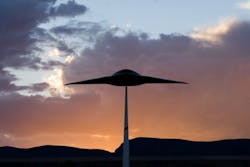NAWCAD test range engineer develops artificial intelligence, machine learning system for radar data
By NAWCAD officials
Electrical Engineer Stephen Itschner at the Atlantic Test Range's (ATR) at Naval Air Warfare Center Aircraft Division (NAWCAD) in Patuxent River, Maryland, is developing an artificial intelligence (AI) system with the potential to teach itself how to recognize and remove external interference from radar signals.
The AI system is an outgrowth of Ph.D. research into pulsars and mysterious cosmic signals called fast radio bursts conducted by ATR’s Itschner.
“I’m hoping it will help us automate a process that’s now very time consuming because we have to do it all by hand,” says Itschner, who works with ATR’s Advanced Dynamic Aircraft Measurement System (ADAMS) group.
If successful, Itschner’s system will be integrated into ADAMS, which provides radar cross-section data from aircraft during flight tests.
“Radar cross-section is just a measure of how big a target looks to a radar,” Itschner affirms. “It’s more related to electrical size than to actual physical size.” Radar signals bouncing back from an aircraft can be contaminated with external Radio Frequency Interference or RFI, he adds.
“It’s essentially the same as the static you hear on a radio when there’s lightning nearby,” Itschner says. “It can come from other radar sites, walkie-talkies, military radios, boat radios, even garage door openers.”
When plotted on an x-y graph, RFI appears as sharp peaks throughout the radar signal, making it hard to tell what represents the true radar return from an aircraft and what is coming from unwanted external sources.
“Radar cross-section post-analysis is very labor-intensive,” explains Jim Ashley, head of ATR’s Aircraft Signature and Avionics Measurement branch. “We’re hoping Steve’s research will lead to an 80 percent solution – letting the machine do 80 percent of the work before we turn it over to our human analysts.”
Itschner presented his initial results with a limited set of data at a meeting last week to the country’s top radar experts at the National Radar Cross Section Test Facility (NRTF) managed by Holloman Air Force Base near Alamogordo, New Mexico.
According to Itschner, his system achieved 80 percent correct RFI classifications with almost no false positives, that is, virtually no misidentification of true radar returns as RFI when using a “proof-of-concept” set of radar data from a Learjet. He trained the AI system on 90 percent of the Learjet data, then tested it against the remaining 10 percent which the system had not encountered before.
“I've gotten it to train and test well on one class of target,” Itschner says. “But I haven't yet looked at whether that type of training will extend to, say, a helicopter or other type of jet.”
Ashley said the ADAMS equipment is being upgraded to handle new, more complex aircraft programs that will require far greater data analysis capability. “It’s simply not going to be practical to continue using people to do all of it.”
NRTF engineers at the conference have come to similar conclusions, Itschner says. “They independently found they’re going to have the same type of problem for a slightly different application and would need a solution similar to the one we’re working on. It gave me a nice warm feeling to know we’re on a promising track.”
The similarities between Itschner’s work with radar and his Ph.D. research in radio astronomy led him to develop the artificial intelligence system, or machine learning, as he calls it. For his Ph.D. Itschner's working on instruments and signal-processing techniques to identify fast radio bursts, which are very powerful but extremely brief eruptions of energy from deep space.
“They’re very mysterious signals and no one knows quite what they are,” Itschner says. “They only last for a millisecond and they’re completely unpredictable.”
A J-UCAS aircraft body sits on a minimally reflective target pylon for radar cross-section testing at the National Radar Cross Section Test Facility.
Itschner is looking for commonalities among fast radio bursts, radar and RFI to develop machine learning systems to analyze them. He’s come up with a machine learning algorithm – a series of computer instructions – called a Convolutional Neural Network (CNN). The CNN is able to identify whether a piece of radar data is corrupted with RFI or not. In his astronomy research, he uses a neural network to determine whether data captured by a radio telescope comes from a fast radio burst or not.
“People can learn to see the difference without too much training, and CNNs are really, really good at mimicking human vision performance,” Itschner describes. “To hand-design an algorithm that can see the same differences people can, an engineer traditionally would choose features that would help discriminate between objects – two types of fish for example. I would say, ‘let’s look at the length of the fish and the number of fins it has’. I’d just try different things and then build a system around that.”
But that traditional approach restricts the algorithm’s discriminating ability, Itschner says. “Its accuracy is limited by the engineer’s imagination.”
So instead of telling his algorithm to look for specific characteristics of a real radar return data versus RFI, Itschner lets the CNN figure them out for itself. “All you do is give the algorithm a bunch of examples and an answer key that says what class each example really belongs to, and the machine is able to learn the difference on its own. Eventually it learns to make correct decisions on new data so that a human doesn’t need to examine it.”
Itschner’s initial results are encouraging, Ashley says. “The next step is to buy hardware for the higher processing power needed to train the system for a wider range of radar data.” The equipment is expected to arrive at ATR in time to begin running AI training algorithms next month. “We’re not sure yet if it’s the right way forward,” he said, “but Steve’s work will help us narrow down how best to apply it to ATR.”


